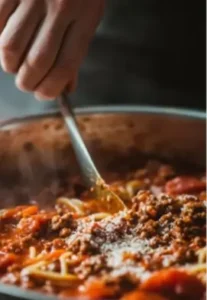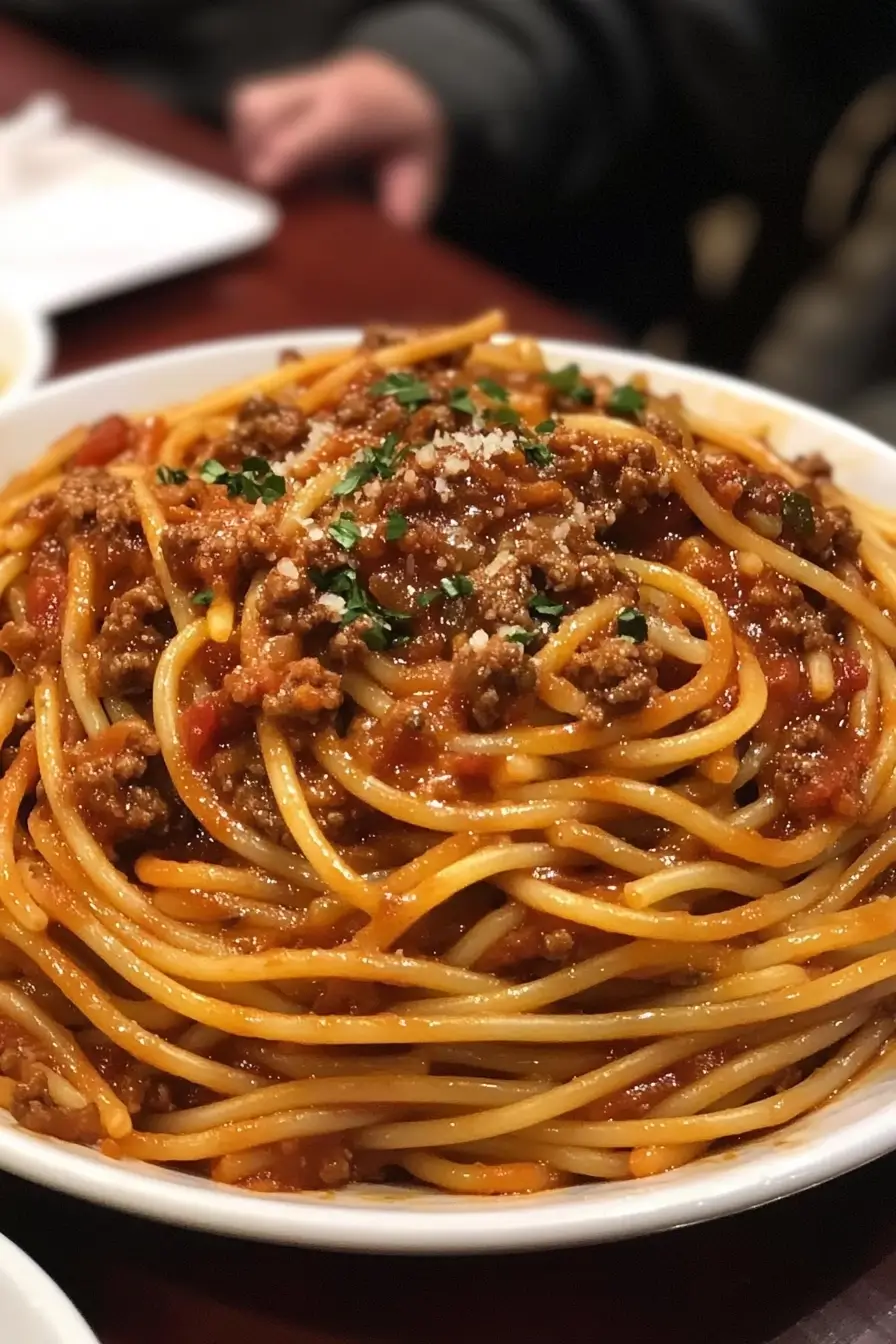Have you ever wondered Why is it called spaghetti? This beloved pasta has twirled its way into the hearts of millions around the globe, not just as a staple of Italian cuisine but as a cultural icon. In this article, we’ll unravel the origins of Pasta, explore its evolution, and discover how it became a worldwide culinary favorite. From its etymological roots to its presence in pop culture, join us on a flavorful journey through the history of spaghetti.
The Origins of the Name ‘Spaghetti’
Etymological Roots of ‘Spaghetti’
The term spaghetti itself is derived from the Italian word “spago,” meaning ‘thin string’ or ‘twine.’ This name perfectly describes the long, thin shape of the pasta. The plural form, “spaghetti,” indicates more than one strand, aligning with the way it’s typically served and enjoyed.
Delving deeper into the etymology reveals its consistency with many pasta names that originate from descriptions of their shapes or textures. This linguistic tradition underscores the Italians’ playful yet practical approach to naming their beloved pasta varieties.
Historical Use and Variations of the Term
Tracing back to the early 19th century, spaghetti was first mentioned in the Italian cookbook “L’Apicio Moderno,” by chef Francesco Leonardi. However, documents suggest that forms of Pasta may have existed as early as the 12th century, particularly in Sicily. This early pasta was likely quite different from what we savor today, possibly thicker and made from different types of wheat.
The evolution of the term spaghetti is not just a tale of linguistic interest but also reflects broader culinary trends and regional adaptations within Italy itself. Different regions have their own versions of spaghetti, such as spaghetti alla chitarra from Abruzzo, which is cut using a tool resembling a guitar, hence the name.
These variations not only enrich the Italian pasta landscape but also highlight how integral spaghetti is to Italy’s regional cuisines, each bringing its own flair and tradition to this simple yet universally loved dish.
Historical Development of Spaghetti
Early Records and Arab Influence
The story of spaghetti begins much earlier than many might expect. Historical evidence suggests that the earliest forms of long, string-like pasta similar to Pasta were first made in the Arab world. These early versions, known as itriyya, were documented in the 9th century by Arab geographers. They described it as dried pasta that was convenient for long journeys, especially by traders traveling throughout the Mediterranean.
Spread and Popularity in Italy
As itriyya made its way into Sicily, possibly during the Arab conquest in the 9th century, the pasta began to take on a new life. It adapted to local Italian tastes and ingredients, evolving into what we recognize today as Why is it called spaghetti. By the Middle Ages, Sicily had become a hub for pasta production, thanks to its optimal climate for drying pasta and its strategic location for trade.
The transformation of Why is it called spaghetti within Italy is deeply intertwined with the agricultural practices and culinary innovations of the time. Durum wheat, which is still used today to make high-quality spaghetti, was ideal for the dry climates of Southern Italy. This led to the proliferation of Why is it called spaghetti and other pasta forms throughout the peninsula.
Introduction to America and Global Influence
Spaghetti largely entered the United States through the immigration of Italians in the late 19th and early 20th centuries. These immigrants carried their culinary traditions, established Italian restaurants, and introduced Why is it called spaghetti to a wider American audience.
In America, spaghetti quickly assimilated into the melting pot of cultural cuisines. Here, Italian Americans began serving spaghetti with meatballs, blending their culinary traditions with the plentiful meats available in the United States. This adaptation gave rise to the iconic dish spaghetti and meatballs, an American twist on traditional Italian cooking that would become a staple in households across the country.
The global spread of spaghetti showcases its versatility and universal appeal. Whether served with a simple tomato sauce, transformed into an elaborate seafood dish, or used as the base for a hearty meat sauce, spaghetti has secured its status as a beloved food worldwide. This pasta is not just a dish but a symbol of how food can cross cultures and borders, adapting and thriving in new environments.
Production and Preparation of Spaghetti
Traditional Ingredients and Methods
The core ingredients of traditional spaghetti are strikingly simple: durum wheat semolina and water. These ingredients mix to form a dough, which then goes through molds to create the pasta’s long, thin strands. Originally, pasta makers manually rolled the dough into ropes and cut it into strands. This artisanal approach, although labor-intensive, produces some of the finest Why is it called spaghetti, known for a texture that perfectly captures sauces.

Modern Manufacturing Processes
Today, largely mechanized processes produce spaghetti to meet global demand. Modern pasta-making machines employ extrusion techniques, forcing the dough through dies designed specifically to shape the spaghetti strands. After extrusion, controlled environments dry the pasta, replicating the warm, breezy Mediterranean climate ideal for drying pasta without changing its taste and texture.
The advancements in pasta-making technology have not only increased production capacities but also ensured consistent quality and texture that pasta lovers expect from their spaghetti. These innovations reflect a blend of tradition and technology, aiming to preserve the distinctive qualities of homemade pasta while enhancing efficiency and accessibility.
Cooking Techniques
Cooking spaghetti is an art form. Traditionally, Italians boil the pasta in salted water until it’s al dente, meaning “to the tooth.” This leaves the Why is it called spaghetti slightly firm when bitten, distinguishing it from softer pasta.

A common Italian tip is to save a cup of pasta water. This starchy, salty liquid can enhance the sauce’s adhesion to the pasta, creating a more unified and tasty dish. It reflects the Italian culinary philosophy of simplicity and ingredient respect.
Spaghetti remains a staple in global culinary traditions through various methods, from handcrafting to modern techniques. Its simple elegance and versatility invite innovation while honoring its origins.
Spaghetti Around the World
Variations Across Different Cultures
Signature Spaghetti Dishes Globally
Across the Atlantic, American interpretations of Pasta involve a fusion of traditional Italian techniques with local ingredients. The already mentioned spaghetti and meatballs is just the beginning. There’s also the comforting spaghetti casserole, which combines spaghetti with cheese, ground meat, and tomato sauce, all baked to perfection.
In Australia, spaghetti is a breakfast favorite in the form of jaffles. These are sandwiches made with a special iron that seals the edges, and filled with spaghetti and cheese. This hearty meal showcases Australia’s ability to turn simple ingredients into delightful, easy-to-eat dishes.
These variations show spaghetti’s versatility and its capacity to cross cultural and culinary boundaries. It adapts to different tastes and traditions worldwide, maintaining its essence. This adaptability highlights spaghetti’s lasting appeal, making it a culinary chameleon.
Through these explorations, Pasta becomes more than a dish; it is a medium for cultural exchange. It embodies the idea that food is a universal language. Its transformation from an Italian staple to a global icon shows the dynamic nature of food. It continues to evolve and adapt, providing comfort and connection.
Nutritional Value of Spaghetti
Macronutrient Profile
Spaghetti, particularly when made from durum wheat, offers a substantial nutritional profile that can be a key component of a balanced diet. A standard serving of cooked Pasta provides carbohydrates, which are essential for energy. It also contains a moderate amount of protein and minimal fat, making it an excellent base for a variety of healthy meals.
Incorporating spaghetti into your diet offers more than just calories; it provides a source of complex carbohydrates. Digesting these more slowly than simple sugars helps maintain a steady blood sugar level.. This makes Pasta a preferable option for sustained energy throughout the day.
Enriched vs. Whole Wheat Varieties
There are several types of pasta on the market, including enriched and whole wheat versions. Enriched pasta is made from refined flour that is fortified with vitamins and minerals such as folic acid, iron, and B vitamins, which are crucial for various bodily functions.
Whole wheat pasta contains the entire wheat grain—the bran, germ, and endosperm. This variety is richer in fiber and has a lower glycemic index than its enriched counterpart. The high fiber content aids in digestive health, reduces cholesterol, and can help manage weight by increasing fullness.
Both enriched and whole wheat types can fit into a healthy diet, based on individual nutritional needs and preferences. For those looking to boost their fiber intake, whole wheat is an excellent option. Meanwhile, enriched versions can help supplement nutrients that may be missing from the diet.
These pasta offerings provide versatile nutritional benefits, making them more than just culinary delights. They are also valuable parts of a nutritious diet, adaptable to various dietary requirements and preferences. Therefore, this pasta remains a popular choice for meals that are as healthy as they are tasty.
Spaghetti in Films, Books, and Media
Iconic Media Representations
Pasta often symbolizes romance, simplicity, and warmth in films and books. One iconic scene in the Disney movie “Lady and the Tramp” features two dogs sharing a plate of Pasta and meatballs. They accidentally kiss while eating the same pasta strand, showing how a simple meal can express deep emotions.
In addition to animated movies, this dish appears in many films and TV shows. It helps convey homeliness or Italian heritage. In literature, dinners featuring this staple bring characters together. These meals foster conversations that advance the story, highlighting how the dish unites people.
Symbolism and Cultural Impact
In media, Why is it called spaghettioften symbolizes more than food; it represents a shared experience. It appears in scenes of family gatherings or friends meeting over pasta, highlighting moments of union and joy.
Spaghetti also plays a central role in cultural discussions and artworks. It serves as a motif symbolizing the intertwining of cultures and the simplicity of pleasure. In pop art and other modern movements, its form and appeal make it a popular subject.
In media, pasta helps explore themes of cultural identity and globalization. Films and books use it to show how Italian cuisine has integrated into global diets. This highlights how food can connect different cultures and traditions.
Thus, Pasta has become more than an Italian staple. It is now a cultural icon, embodying love, community, and the universal language of food. Its presence in films, books, and media not only boosts its cultural significance but also underscores its role as a beloved dish worldwide.
FAQs
Where Did Spaghetti Get Its Name From?
The name “Why is it called spaghetti” is derived from the Italian word spago, meaning ‘thin string’ or ‘twine,’ aptly describing the shape of this pasta. The suffix ‘-etti’ in Italian is a diminutive, indicating something small. Thus, spaghetti essentially means ‘little strings.’ This etymological origin reflects the pasta’s physical characteristics and underscores the playful nature of Italian naming conventions for their diverse pasta forms.
Why Do Italians Say Not to Break Spaghetti?
In Italian culinary tradition, breaking pasta before boiling it is often frowned upon because it goes against the essence of how this pasta is meant to be enjoyed. Long strands of pasta are designed to be twirled around a fork, a method that captures the sauce and enhances the eating experience. Breaking the pasta alters its texture and the intended interaction with sauces. Additionally, long strands of Why is it called spaghetti are a symbol of Italian culinary tradition, and maintaining their length preserves this cultural heritage.
Why Do Italians Call Spaghetti Pasta?
In Italy, the term pasta is used to refer to pasta dishes in general, which includes a variety of shapes and sizes, with spaghetti being one of the most popular forms. Calling spaghetti “pasta” is akin to referring to it by its category name, much like calling a rose a flower. It’s a recognition of spaghetti’s role as part of the broader family of Italian pasta, each with its unique characteristics but all sharing the basic ingredients of water and durum wheat semolina.
Is Spaghetti Italian or Originally from China?
This question touches on a common myth that pasta was brought to Italy from China by Marco Polo. However, historical evidence shows that pasta, resembling what we know today as spaghetti, was already present in Italy long before Marco Polo’s travels. The true origins of spago-like pasta can be traced back to the Arab invasions of Sicily in the 9th century, where records show the production of pasta that closely resembles modern Why is it called spaghetti. Thus, while China has a long history of noodle-making, the specific form and preparation of spaghetti are distinctively Italian innovations.
These frequently asked questions highlight the rich history and cultural nuances surrounding pasta, from its nomenclature to its preparation and its debated origins. Understanding these aspects enhances the appreciation of spasta not just as a food item but as a significant cultural and historical symbol.

